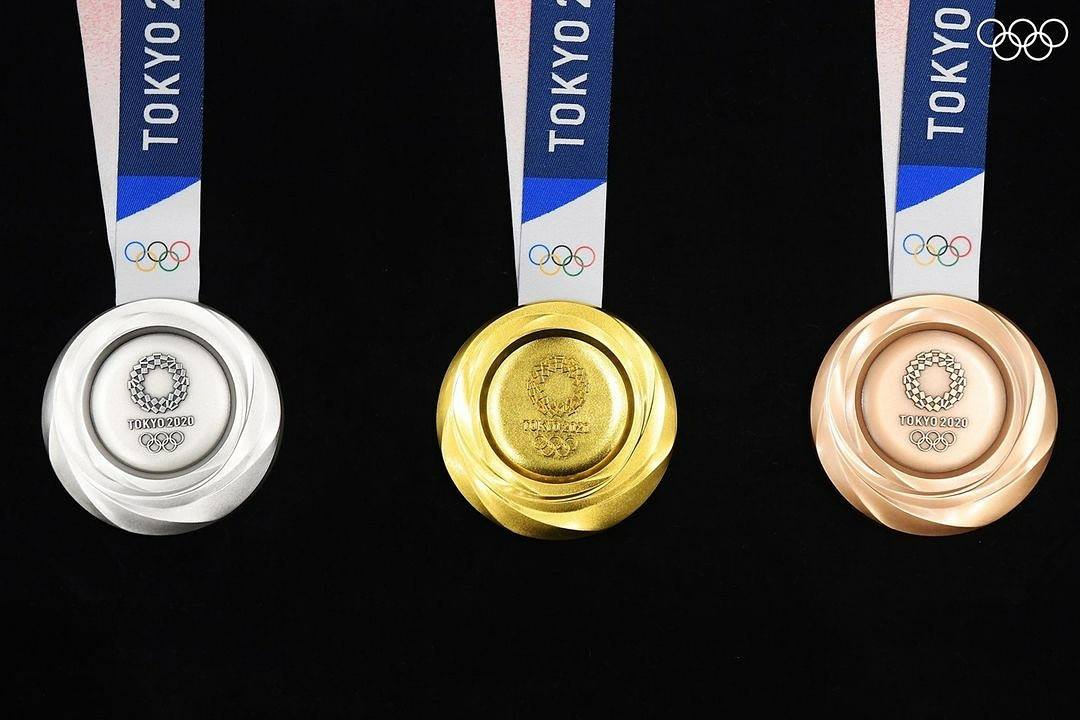Are Olympic gold medals actually gold? Throughout both ancient and modern-Olympic history, the answer to this question has varied.
In ancient Greece, no medals were given to competitors at the Olympic Games. Instead, winning athletes at each Games were given olive branch wreaths, made from the branches of an olive tree in Olympia.
The tradition of giving victors an olive branch continued to the first modern Olympic Games in 1896. This was also the first edition of the Games to ever award medals to the competitors. However, no gold medals were awarded as the winner of each event received a silver medal, while the runner-up received a bronze medal. A similar tradition continued at the 1900 Olympic Games, which saw gold plated silver medals awarded to the first place finisher in only specific events, with a majority of the events being contested for cups or other trophies. This was the first Olympics where silver and bronze medals were awarded for 2nd and 3rd place finishers, in those particular events. Notably, all of the medals were also square.
The first use of the modern-day medal system did not occur until the 1904 Olympic Games in St. Louis, Missouri. These Games were the first to award the traditional gold, silver, and bronze medals to the top three finishers in each event. The gold medals presented at these Games consisted of solid gold, as the metal was cheaper to obtain prior to World War I. The 1908 and 1912 Olympic Games also utilized solid gold medals, however, these were the last ones to do so.
After 1912, the 1916 Olympic Games were canceled due to World War I and the price of gold skyrocketed due to demand from the war. Thus, host countries once-again began to utilize gold plated silver within the medals. In these “gold” medals, the core of the medal is made of silver, with a thin layer of gold covering the outside to give the appearance of a gold medal.
This trend has continued into the present-day. Currently, the International Olympic Committee states that an official Olympic gold medal must consist of at least 92.5% silver, and must contain a minimum of 6 grams of gold. In order to make any alterations to the design of the medals, a host country must obtain explicit permission from the International Olympic Committee. This occurred most notably in 2008, when Olympic organizers incorporated jade into the design of each of the three Olympic medals.
The logic behind this decision makes sense, in addition to the cost factor, gold, compared to silver, is an extremely “soft” metal. An Olympic medal made completely of gold would be much easier to bend or damage as compared to the silver-plated medals often used.
For the most recent Summer Olympic Games in 2021, organizers from the Tokyo Olympic Committee decided to use recycled materials to make the medals, collecting old cell phones from the citizens of Tokyo to do so. This followed the same idea that the 2016 Rio Olympic organizers had, as they also used recycled materials in their medals.
Despite their priceless sentimental value, Olympic medals actually are not worth as much as one would expect. When we analyzed the value of the 2020 Olympic medals back in 2021, the gold medals only held a market value of $790.34 based on the value of their raw materials. Over time, the value of gold has varied significantly. In 1915, the first year for which data was available, gold cost an average of $583 per ounce. This number plummeted during the 1920s and the 1940s, then rose significantly over the following decades. In 1980, gold hit its all-time high of approximately $2,200 per ounce. Today, it goes for approximately $1,900 per ounce.
Gold Value Per Ounce 1915 – Present (via Macrotends)

At auction, the value of an Olympic medal varies significantly based on the year it was made, the color of the medal, and the athlete who won the medal. Gold medals usually sell for between $20,000 and $50,000, with older Olympic medals selling for the most money. From there, silver medals sell for $10,000 to $30,000, while bronze medals usually sell for less than $10,000. However, medals won by notable athletes tend to sell for much more. An Olympic gold medal won in the “miracle on ice” hockey game at the 1980 Olympic Games recently sold for $310,700. In 2013, one of Jesse Owens’ gold medals from the 1936 Olympic Games in Berlin sold for a whopping $1.46 million. Another one of Owens’ gold medals sold for $615,000 in 2016. It is estimated that Michael Phelps’ Olympic gold medals could sell for at least $100,000 each, with certain medals worth much more than that, like his record-breaking 8th gold medal from the 2008 Olympic Games.
Some Olympic gold medals have also been auctioned off for charity in the past. Anthony Ervin auctioned off his gold medal from the 2000 Olympic Games in 2005, donating the proceeds to the Tsunami Relief Fund. At the time, his medal sold for $17,100, a price that adjusts to $27,200 in 2023.
Though it is not an Olympic gold medal, sprint star David Popovici recently donated his gold medal from winning the 200 freestyle at the 2022 World Championships to benefit children’s cancer research. Popovici posted a video showing the medal being melted down, with the money from its materials being donated.


platinum is mined from Russia, so dont make Putin more rich than he already is ! South Africa is the # 1 producer of platinum.
Platinum would be a nice replacement for gold — stronger, heavier, hypo-allergenic, and less costly, I think.
Platinum currently costs just over half the price of gold.
Thank you for reinforcing my point
On a, not entirely unrelated note, that seemed worth mentioning: Mallory Weggemann appeared on the finale of Top Chef World All-Stars – giving Paralympic swimming some nice prime time attention.